Electron Probe Micro-Analyzer Studies and Raman Spectroscopic Characterization of Plagioclase in Basaltic Rocks from the Asal–Ghoubbet Area, Republic of Djibouti
Abstract
:1. Introduction
2. Geological Background
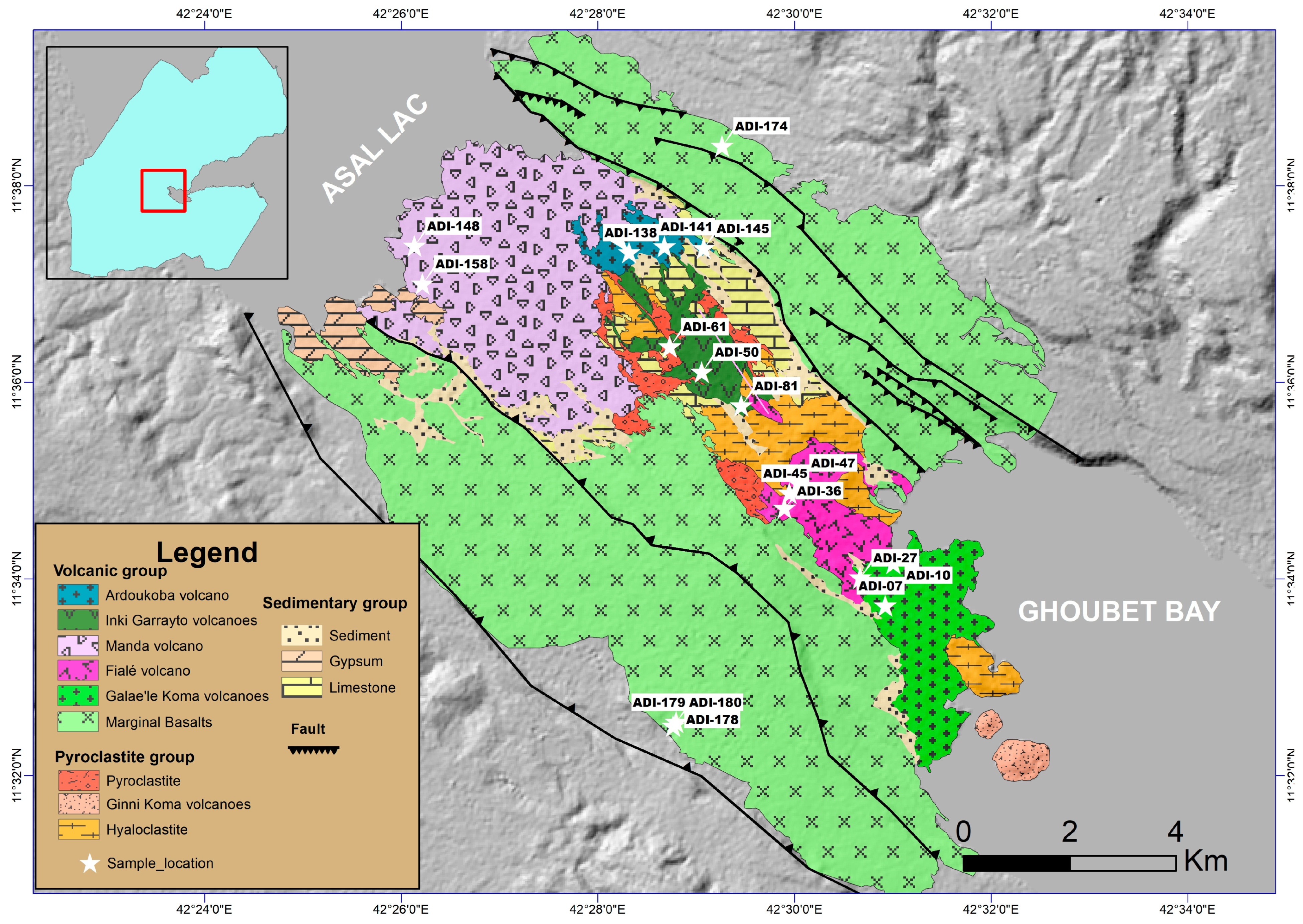
3. Sampling and Analytical Methods
4. Results
4.1. Petrography and Mineral Chemistry
4.2. Raman Characteristics of Plagioclases
4.3. Major Element Composition of Plagioclases
5. Discussion
5.1. The Nature of Plagioclases
5.2. H2O Content
5.3. Phase Equilibria
5.4. Plagioclase–Liquid Thermobarometry Calculations
5.5. Magma Reservoir Modeling
6. Conclusions
Supplementary Materials
Author Contributions
Funding
Data Availability Statement
Acknowledgments
Conflicts of Interest
References
- Stieltjes, L. L’axe Tectono-Volcanique d’Asal (Afar Central—T.F.A.I.). Ph.D. Thesis, Paris-Sud University, Paris, France, 1973. [Google Scholar]
- Vellutini, P. The Manda—Inakir rift, republic of Djibouti: A comparison with the Asal rift and its geodynamic interpretation. Tectonophysics 1990, 172, 141–153. [Google Scholar] [CrossRef]
- Vellutini, P.; Piguet, P.; Recroix, F.; Demange, J.; Abdallah, A. Carte Géologique de la République de Djibouti au 1/100000: Notice d’Asal. Edition BRGM. Published online 1993. Available online: https://drive.google.com/file/d/12CfK-0RyH_-JAI5Fhcb7HWEB75-E_j-C/view (accessed on 22 January 2024).
- Stieltjes, L.; Joron, J.L.; Treuil, M.; Varet, J. Le rift d’Asal, segment de dorsale emerge; discussion petrologique et geochimique. Bull Société Géologique Fr. Bull. Soc. Geol. Fr. 1976, 18, 851–862. [Google Scholar] [CrossRef]
- Pinzuti, P.; Humler, E.; Manighetti, I.; Gaudemer, Y. Petrological constraints on melt generation beneath the Asal Rift (Djibouti) using quaternary basalts. Geochem. Geophys. Geosyst. 2013, 14, 2932–2953. [Google Scholar] [CrossRef]
- Iltireh, A.D. Petrology of Volcanic Rocks from Asal-Ghoubet Area: Magma Genesis and Its Evolution, Djibouti. Ph.D. Dissertation, Ankara University, Ankara, Turkey, 2024. [Google Scholar]
- Bizouard, H.; Clocchiatti, R.; Marinelli, G. Les tholeiites a olivine a megacristaux de bytownite du rift d’Asal (Republique de Djibouti); quelques suggestions pour un modele genetique. Bull. Soc. Geol. Fr. 1980, 22, 845–850. [Google Scholar] [CrossRef]
- Flower, M.F.J. Accumulation of calcic plagioclase in ocean-ridge tholeiite: An indication of spreading rate? Nature 1980, 287, 530–532. [Google Scholar] [CrossRef]
- Hansen, H.; Grönvold, K. Plagioclase ultraphyric basalts in Iceland: The mush of the rift. J. Volcanol. Geotherm. Res. 2000, 98, 1–32. [Google Scholar] [CrossRef]
- Lange, A.E.; Nielsen, R.L.; Tepley, I.I.I.F.J.; Kent, A.J.R. The petrogenesis of plagioclase-phyric basalts at mid-ocean ridges. Geochem. Geophys. Geosyst. 2013, 14, 3282–3296. [Google Scholar] [CrossRef]
- Ruegg, J.C.; Kasser, M. Deformation across the Asal-Ghoubbet Rift, Djibouti, Uplift and crustal extension 1979–1986. Geophys. Res. Lett. 1987, 14, 745–748. [Google Scholar] [CrossRef]
- Manighetti, I.; Tapponnier, P.; Gillot, P.Y.; Jacques, E.; Courtillot, V.; Armijo, R.; Ruegg, J.C.; King, G. Propagation of rifting along the Arabia-Somalia Plate Boundary: Into Afar. J. Geophys. Res. Solid Earth 1998, 103, 4947–4974. [Google Scholar] [CrossRef]
- Jacques, E.; King, G.C.P.; Tapponnier, P.; Ruegg, J.C.; Manighetti, I. Seismic activity triggered by stress changes after the 1978 events in the Asal Rift, Djibouti. Geophys. Res. Lett. 1996, 23, 2481–2484. [Google Scholar] [CrossRef]
- Tazieff, H.; Varet, J.; Barberi, F.; Giglia, G. Tectonic Significance of the Afar (or Danakil) Depression. Nature 1972, 235, 144–147. [Google Scholar] [CrossRef]
- Needham, H.D.; Choukroune, P.; Cheminee, J.L.; Le Pichon, X.; Francheteau, J.; Tapponnier, P. The accreting plate boundary Ardoukôba Rift (northeast Africa) and the oceanic Rift Valley. Earth Planet. Sci. Lett. 1976, 28, 439–453. [Google Scholar] [CrossRef]
- Harrison, C.G.A.; Bonatti, E.; Stieltjes, L. Tectonism of Axial Valleys in Spreading Centers: Data from the Afar Rift, Afar Depression of Ethiopia, 1 A. Pilger, A. Rösler, 178–198. Published online 1975.
- Courtillot, V.; Achache, J.; Landre, F.; Bonhommet, N.; Montigny, R.; Féraud, G. Episodic spreading and rift propagation: New paleomagnetic and geochronologic data from the Afar nascent passive margin. J. Geophys. Res. Solid Earth 1984, 89, 3315–3333. [Google Scholar] [CrossRef]
- Stieltjes, L. Geological Map of Asal Rift. Republic of Djibouti, Scale 1/50000; Bureau de Recherches Géologiques et Minières: Orléans, France, 1980. [Google Scholar]
- Vidal, P.; Deniel, C.; Vellutini, P.J.; Piguet, P.; Coulon, C.; Vincent, J.; Audin, J. Changes of mantle sources in the course of a rift evolution: The Afar case. Geophys. Res. Lett. 1991, 18, 1913–1916. [Google Scholar] [CrossRef]
- Deniel, C.; Vidal, P.; Coulon, C.; Vellutini, P.; Piguet, P. Temporal evolution of mantle sources during continental rifting: The volcanism of Djibouti (Afar). J. Geophys. Res. Solid Earth 1994, 99, 2853–2869. [Google Scholar] [CrossRef]
- Koralay, T.; Kadioglu, Y.K. Reasons of different colors in the ignimbrite lithology: Micro-XRF and confocal Raman spectrometry method. Spectrochim. Acta A Mol. Biomol. Spectrosc. 2008, 69, 947–955. [Google Scholar] [CrossRef] [PubMed]
- Koralay, T. Petrographic and geochemical characteristics of upper Miocene Tekkedag volcanics (Central Anatolia—Turkey). Geochemistry 2010, 70, 335–351. [Google Scholar] [CrossRef]
- Kadıoğlu, Y.K.; Üstündağ, Z.; Deniz, K.; Yenikaya, C.; Erdoğan, Y. XRF and Raman Characterization of Antimonite. Instrum. Sci. Technol. 2009, 37, 683–696. [Google Scholar] [CrossRef]
- Deniz, K. Mica Types as Indication of Magma Nature, Central Anatolia, Turkey. Acta Geol. Sin. -Engl. Ed. 2022, 96, 844–857. [Google Scholar] [CrossRef]
- Iltireh, A.D.; Kadioglu, Y.K. Geochemistry and Petrogenesis of Inki-Garayto Volcano in Asal-Ghoubbet area, Republic of Djibouti. In Proceedings of the 8th International Black Sea Coastline Countries Scientific Research Conference, Sofia, Bulgaria, 29–30 August 2022; pp. 884–893. [Google Scholar]
- Hattori, K.; Sato, H. Magma evolution recorded in plagioclase zoning in 1991 Pinatubo eruption products. Am. Mineral. 1996, 81, 982–994. [Google Scholar] [CrossRef]
- Joron, J.L.; Treuil, M.; Jaffrezic, H.; Villemant, B. Etude geochimique des elements en traces dans les series de roches volcaniques du rift d’Asal; identification et analyse des processus d’accretion. Bull. Soc. Geol. Fr. 1980, 7, 851–861. [Google Scholar] [CrossRef]
- Putirka, K.D. Thermometers and Barometers for Volcanic Systems. Rev. Miner. Geochem. 2008, 69, 61–120. [Google Scholar] [CrossRef]
- Putirka, K.D. Igneous thermometers and barometers based on plagioclase + liquid equilibria: Tests of some existing models and new calibrations. Am. Mineral. 2005, 90, 336–346. [Google Scholar] [CrossRef]
- Putirka, K.; Johnson, M.; Kinzler, R.; Longhi, J.; Walker, D. Thermobarometry of mafic igneous rocks based on clinopyroxene-liquid equilibria, 0–30 kbar. Contrib. Mineral. Petrol. 1996, 123, 92–108. [Google Scholar] [CrossRef]
- Klein, E.M.; Langmuir, C.H. Global correlations of ocean ridge basalt chemistry with axial depth and crustal thickness. J. Geophys. Res. Solid Earth 1987, 92, 8089–8115. [Google Scholar] [CrossRef]
- Langmuir, C.H.; Klein, E.M.; Plank, T. Petrological systematics of mid-ocean ridge basalts: Constraints on melt generation beneath ocean ridges. In Mantle Flow and Melt Generation at Mid-Ocean Ridges; American Geophysical Union: Washington, DC, USA, 1992; pp. 183–280. [Google Scholar]
- Gaudin, A.M. Flottation. Ed; McGraw-Hill: New York, NY, USA, 1932. [Google Scholar]
- Treuil, M.; Varet, J. Criteres volcanologiques, petrologiques et geochimiques de la genese et de la differenciation des magmas basaltiques; exemple de l’Afar. Bull. Soc. Geol. Fr. 1973, 7, 506–540. [Google Scholar] [CrossRef]
- Treuil, M.; Joron, J.L. Utilisation des propriétés des éléments fortement hygromagmatophiles pour l’étude de la composition chimique et de l’hétérogénéité du manteau. Bull. Soc. Geol. Fr. 1977, 19, 1197–1205. [Google Scholar]
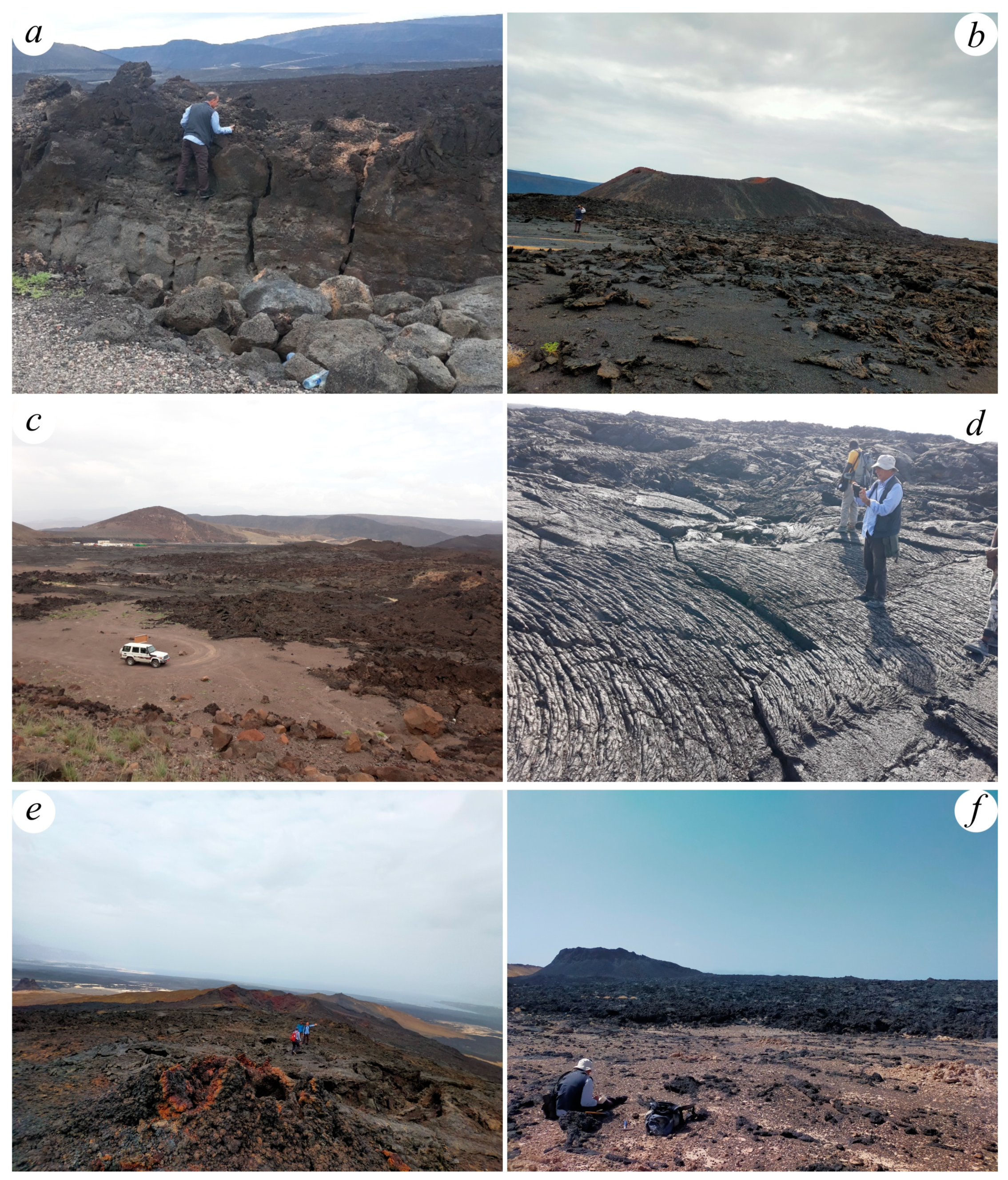
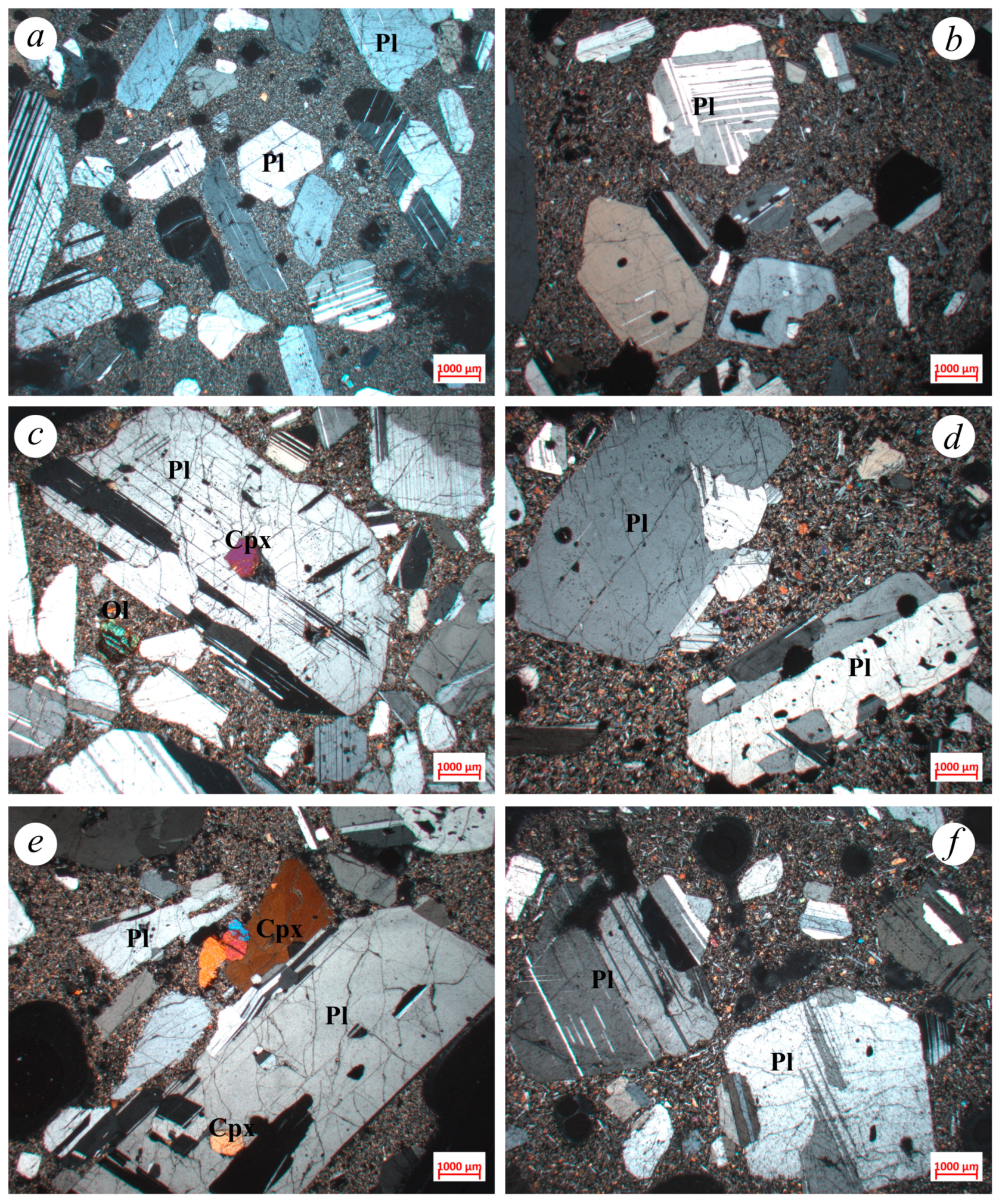
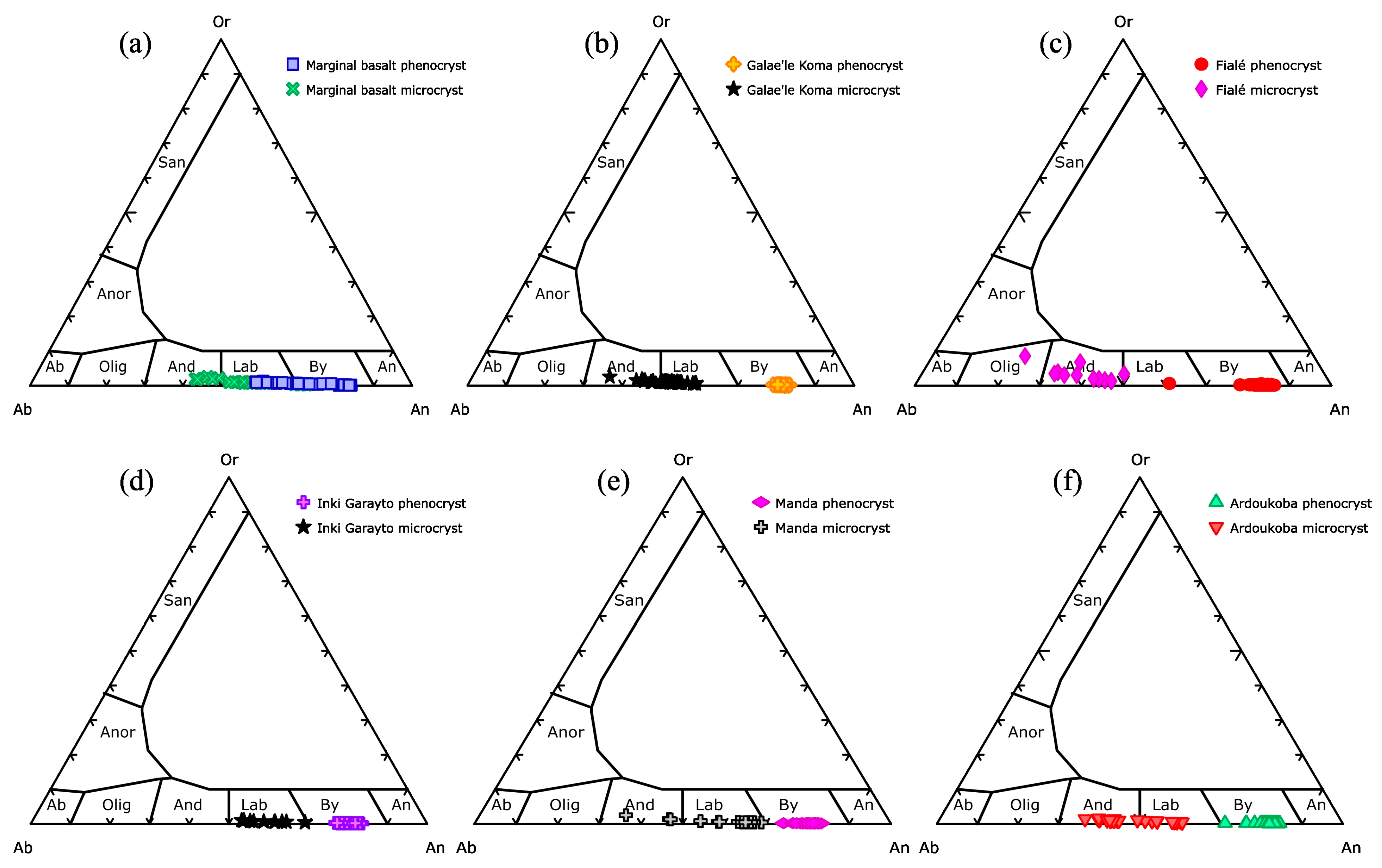

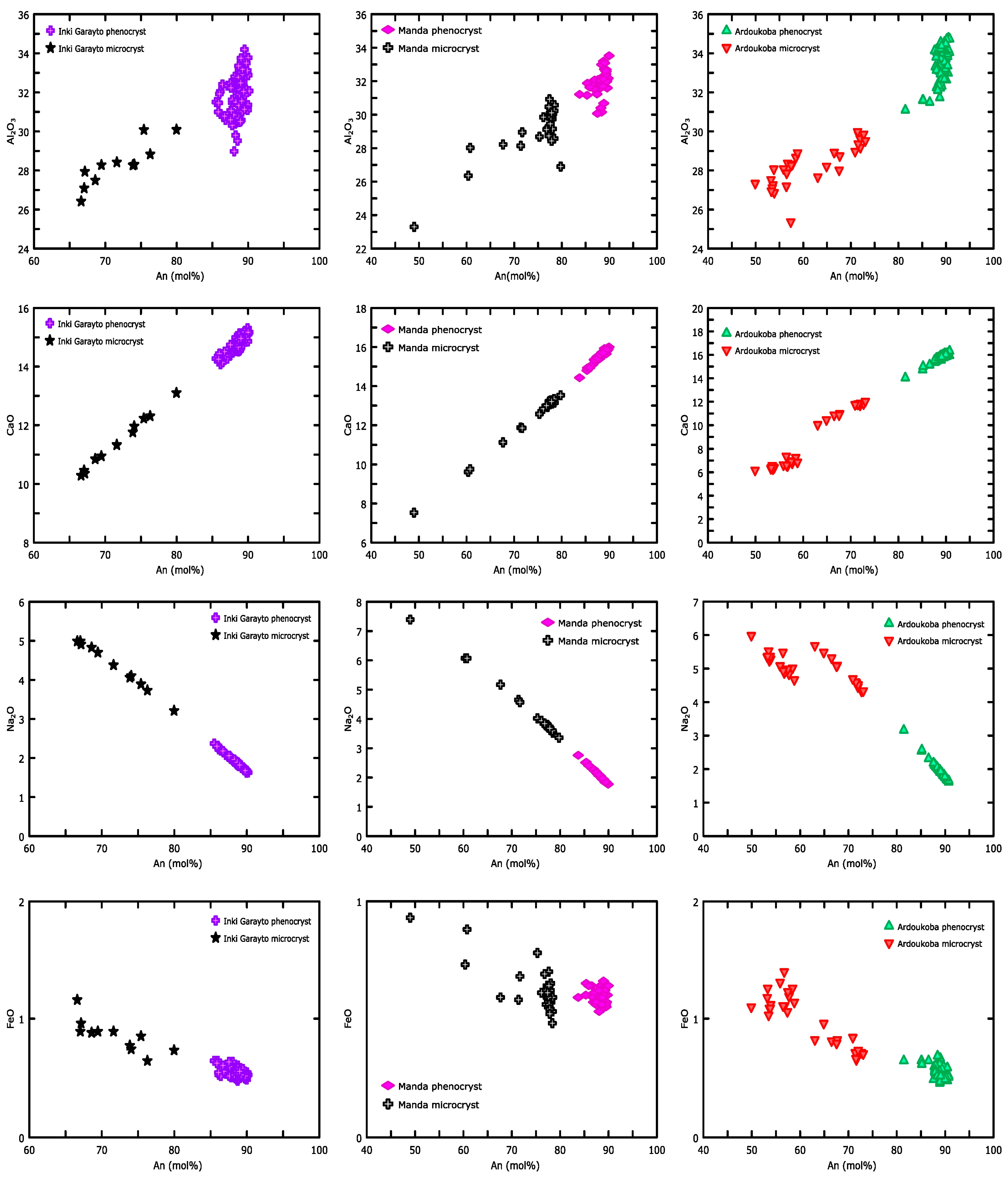
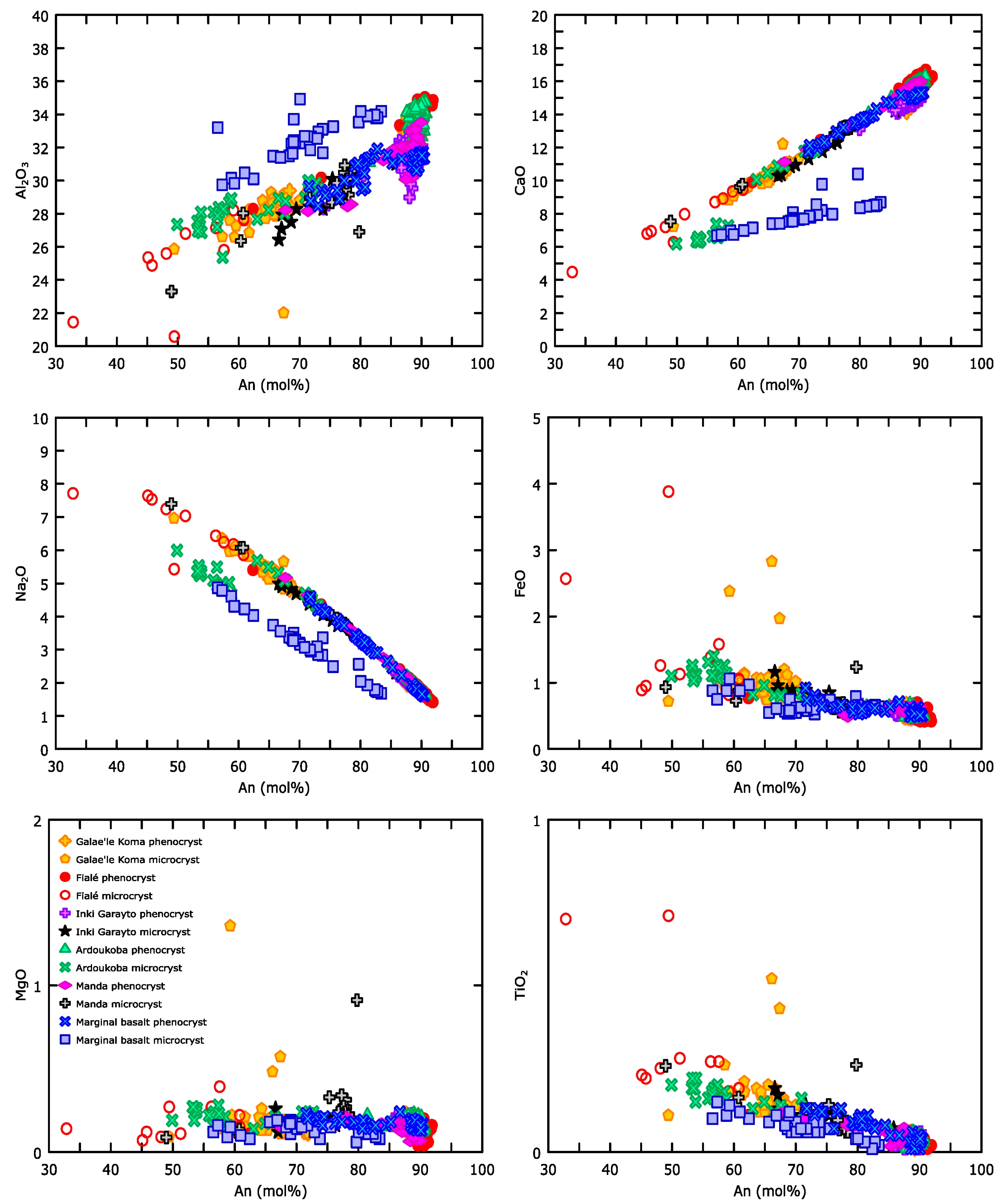

| Volcano Name | Mineral | H2O (wt.%) Max | H2O (wt.%) Min | H2O (wt.%) Average |
|---|---|---|---|---|
| Marginal basalts | Macrocryst | 4.19 | 0.77 | 2.34 |
| Microcryst | 1.60 | 0.23 | 1.08 | |
| Galaé’le Koma volcanoes | Macrocryst | 3.90 | 2.58 | 3.38 |
| Microcryst | 3.05 | 0.24 | 1.07 | |
| Fialé volcano | Macrocryst | 4.42 | 2.37 | 3.46 |
| Microcryst | 3.56 | 1.11 | 2.41 | |
| Manda volcano | Macrocryst | 3.83 | 1.74 | 2.71 |
| Microcryst | 3.22 | 2.00 | 2.80 | |
| Inki Garayto volcanoes | Macrocryst | 4.15 | 2.39 | 3.20 |
| Microcryst | 3.02 | 2.64 | 2.81 | |
| Ardoukoba volcano | Macrocryst | 4.16 | 1.99 | 3.35 |
| Microcryst | 2.65 | 0.58 | 1.71 |
| Volcano Name | Mineral | T (°C) Max | T (°C) Min | T (°C) Average | Pressure (P, kbar) Max | Pressure (P, kbar) Min | Pressure (P, kbar) Average |
|---|---|---|---|---|---|---|---|
| Marginal basalts | Macrocryst | 1216 | 1096 | 1168 | 14.51 | 9.05 | 11.37 |
| Microcryst | 1203 | 1125 | 1177 | 14.84 | 9.10 | 12.58 | |
| Galaé’le Koma volcanoes | Macrocryst | 1174 | 1082 | 1131 | 9.95 | 6.49 | 8.10 |
| Microcryst | 1186 | 1072 | 1156 | 12.46 | 2.99 | 5.51 | |
| Fialé volcano | Macrocryst | 1161 | 1085 | 1124 | 12.58 | 3.92 | 8.24 |
| Microcryst | 1159 | 1094 | 1126 | 10.09 | 4.00 | 6.26 | |
| Manda volcano | Macrocryst | 1176 | 1107 | 1144 | 10.32 | 7.11 | 8.49 |
| Microcryst | 1186 | 1098 | 1171 | 12.87 | 9.47 | 11.67 | |
| Inki Garayto volcanoes | Macrocryst | 1172 | 1094 | 1133 | 13.67 | 6.72 | 9.11 |
| Microcryst | 1186 | 1079 | 1146 | 12.70 | 8.23 | 11.18 | |
| Ardoukoba volcano | Macrocryst | 1169 | 1085 | 1130 | 9.75 | 5.87 | 7.75 |
| Microcryst | 1168 | 1100 | 1142 | 13.31 | 5.09 | 8.94 |
| Volcano Name | Mineral | Pressure (P, kbar) Max | Pressure (P, kbar) Min | Depth (km) |
|---|---|---|---|---|
| Marginal basalts | Macrocryst | 14.51 | 9.05 | 47.88–29.87 |
| Microcryst | 14.84 | 9.10 | 48.97–30.03 | |
| Galaé’le Koma volcanoes | Macrocryst | 9.95 | 6.49 | 32.84–21.42 |
| Microcryst | 12.46 | 2.99 | 41.12–9.87 | |
| Fialé volcano | Macrocryst | 12.58 | 3.92 | 41.51–12.94 |
| Microcryst | 10.09 | 4.00 | 33.30–13.20 | |
| Manda volcano | Macrocryst | 10.32 | 7.11 | 34.06–23.46 |
| Microcryst | 12.87 | 9.47 | 42.47–31.25 | |
| Inki Garayto volcanoes | Macrocryst | 13.67 | 6.72 | 45.11–22.18 |
| Microcryst | 12.70 | 8.23 | 41.91–27.16 | |
| Ardoukoba volcano | Macrocryst | 9.75 | 5.87 | 32.18–19.37 |
| Microcryst | 13.31 | 5.09 | 43.92–16.80 |
Disclaimer/Publisher’s Note: The statements, opinions and data contained in all publications are solely those of the individual author(s) and contributor(s) and not of MDPI and/or the editor(s). MDPI and/or the editor(s) disclaim responsibility for any injury to people or property resulting from any ideas, methods, instructions or products referred to in the content. |
© 2024 by the authors. Licensee MDPI, Basel, Switzerland. This article is an open access article distributed under the terms and conditions of the Creative Commons Attribution (CC BY) license (https://creativecommons.org/licenses/by/4.0/).
Share and Cite
Iltireh, A.D.; Kadioğlu, Y.K. Electron Probe Micro-Analyzer Studies and Raman Spectroscopic Characterization of Plagioclase in Basaltic Rocks from the Asal–Ghoubbet Area, Republic of Djibouti. Minerals 2024, 14, 216. https://doi.org/10.3390/min14030216
Iltireh AD, Kadioğlu YK. Electron Probe Micro-Analyzer Studies and Raman Spectroscopic Characterization of Plagioclase in Basaltic Rocks from the Asal–Ghoubbet Area, Republic of Djibouti. Minerals. 2024; 14(3):216. https://doi.org/10.3390/min14030216
Chicago/Turabian StyleIltireh, Awaleh Djama, and Yusuf Kağan Kadioğlu. 2024. "Electron Probe Micro-Analyzer Studies and Raman Spectroscopic Characterization of Plagioclase in Basaltic Rocks from the Asal–Ghoubbet Area, Republic of Djibouti" Minerals 14, no. 3: 216. https://doi.org/10.3390/min14030216







